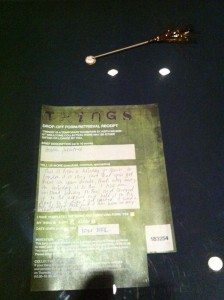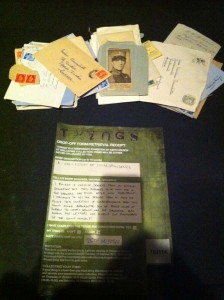October 26th, 2010 by Rachel | Tags: Anthropology, Material Culture, Museum | No Comments »


Golden Palm Tree
Why do people own a toy car or a cup or save old letters from friends and families? This past Sunday, I went to the Wellcome Collections to visit the exhibit called ‘Things’ to explore the reasoning of people owning certain things. This exhibit presented items that people brought to the museum to lend to them or give it to them as a gift . As I was walking through the exhibit, viewing the items, and reading the descriptions written by the owners, I felt like I was reading Daniel Miller’s book, The Comfort of Things. While some of the objects appeared to be strange enough for people to own, there were valid reasons according to the descriptions, which owners wrote. For instance, the toy car displayed at the exhibit was an item to reminisce the relationship between the son and the father who found the toy car in a park that was broken and fixed it for the son. A highlighter was represented as an essential tool for studying and researching and the owner of the highlighter was always reading and studying. A ‘golden palm tree’ from Spain was not only a representation of a travel memory in Spain, but also a rare treasure for a Londoner.

Old Letters
Viewing some of the objects also made me think about the objects I owned. For example, I have a ‘golden palm tree’ too except that it’s blue instead of gold from France. I saved it because it represents my travel memories in southwest France, in particular the last night of the trip when the ‘golden palm tree’ was placed in an enormous ice cream I ate with a special friend. Thus, when I view the object which is tapped in my journal, I think about the ‘time of my life’ in teen years. Highlighter is also a very important object. I have a habit of carrying it around all the time because when I read, I love to highlight so that I can remember important quotes and refer back to them when I need them for papers or blogs I write. The old letters I saw reminded me of letters I saved throughout my childhood. They’re considered treasures because they’re letters from foreign countries and so, seeing what kind of paper and envelopes they used always fascinated me as they were different from the materials I used. Seeing their hand writing was a plus, as I felt that I got to know the person better than seeing a typed up letter because I got to know whether the person was artistic or is sloppy because of the sloppy handwriting or is perfectionist because of its perfect handwriting.
Here is an artist statement by Keith Wilson, the man behind this project:
Sculpture stills the stuff of life much as poetry stills language. While this can cause resentment, it can also open up a rich space full of its own history. Where sculpture is made using pre-existing objects, each brings with it associative meanings from its past life or its language of fabrication: the how and the why of its making and our keeping. Things is an an attempt to open up that space of a moment, and see how our relationship with the material world might be changing.






